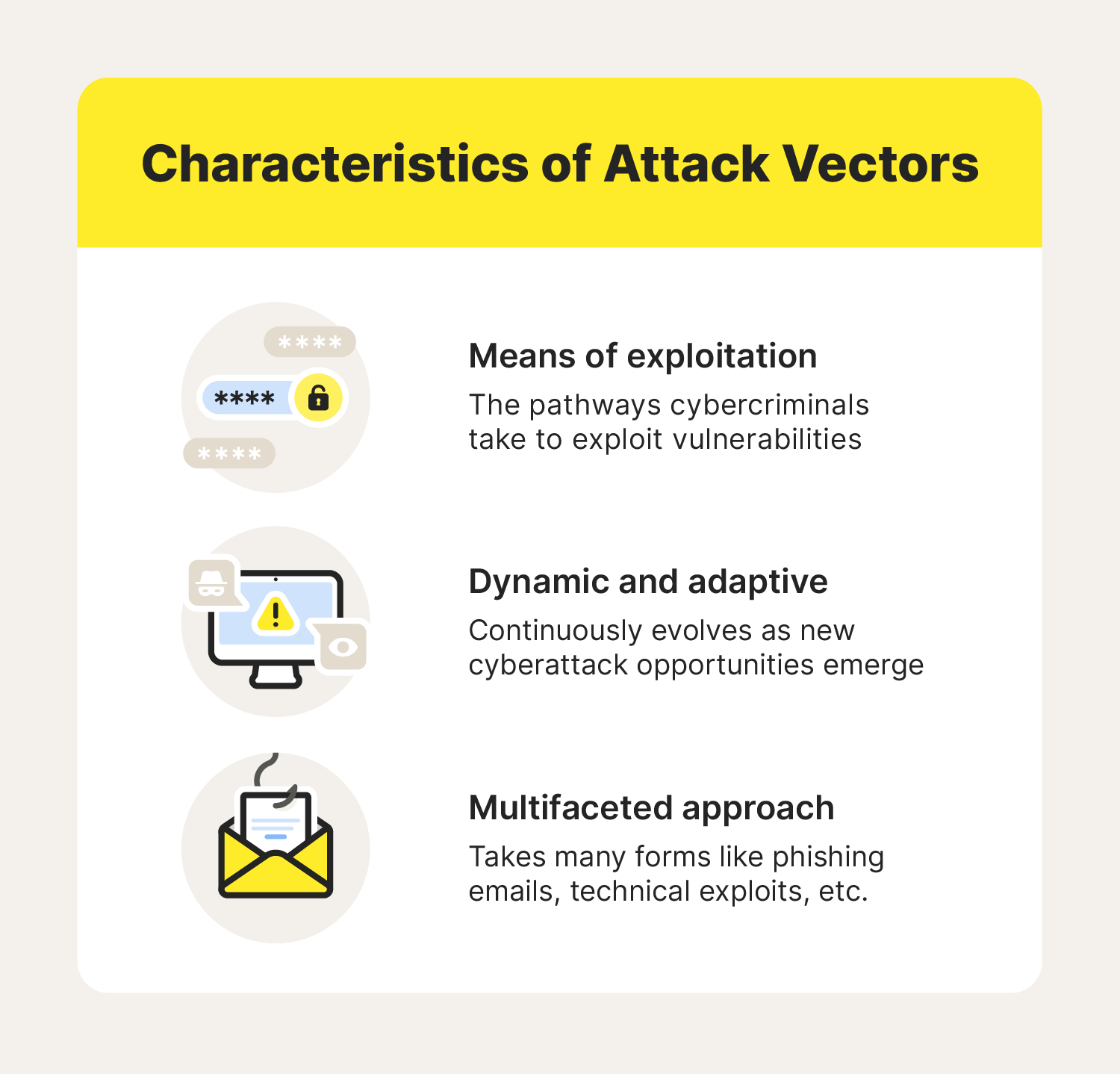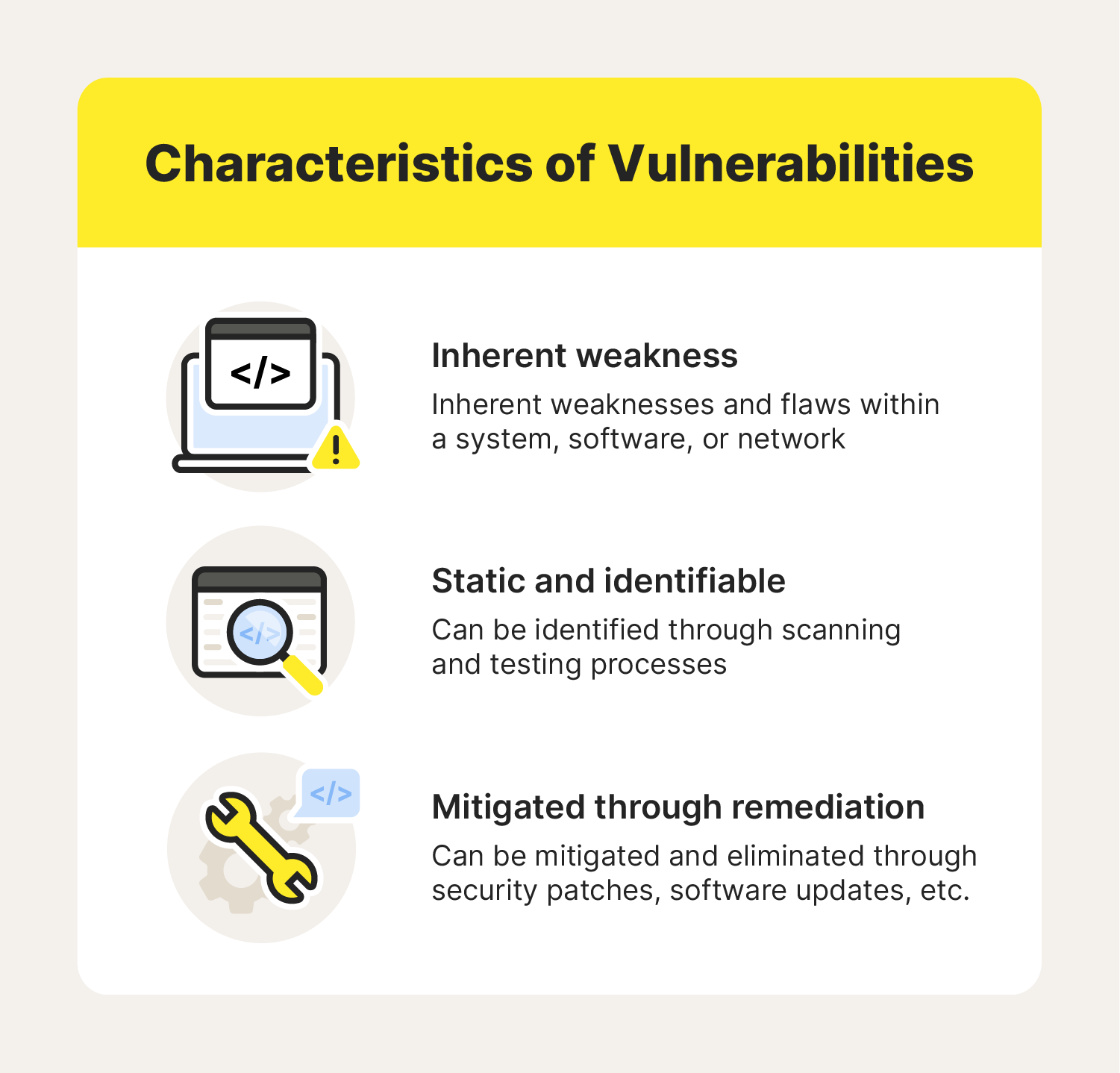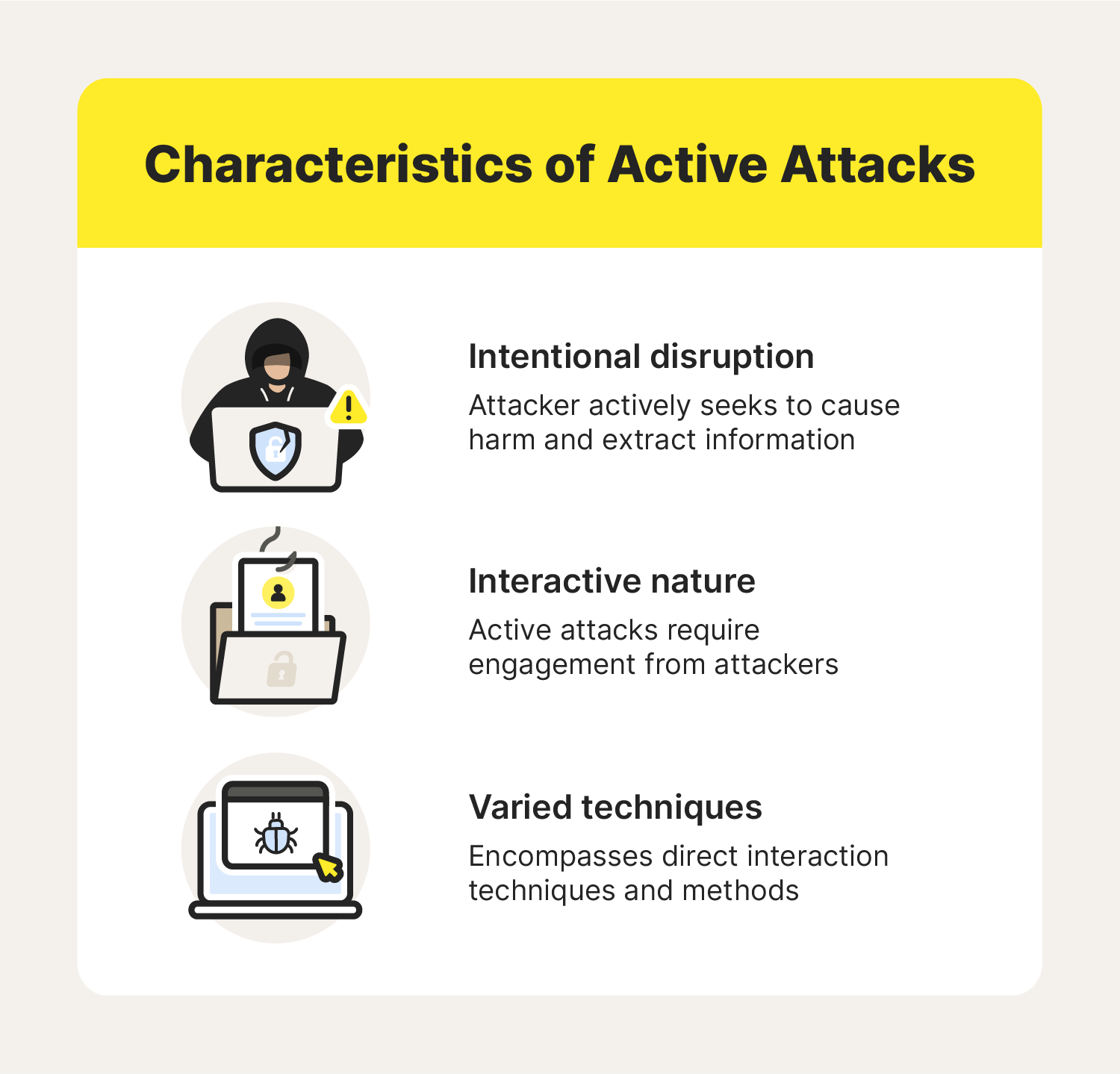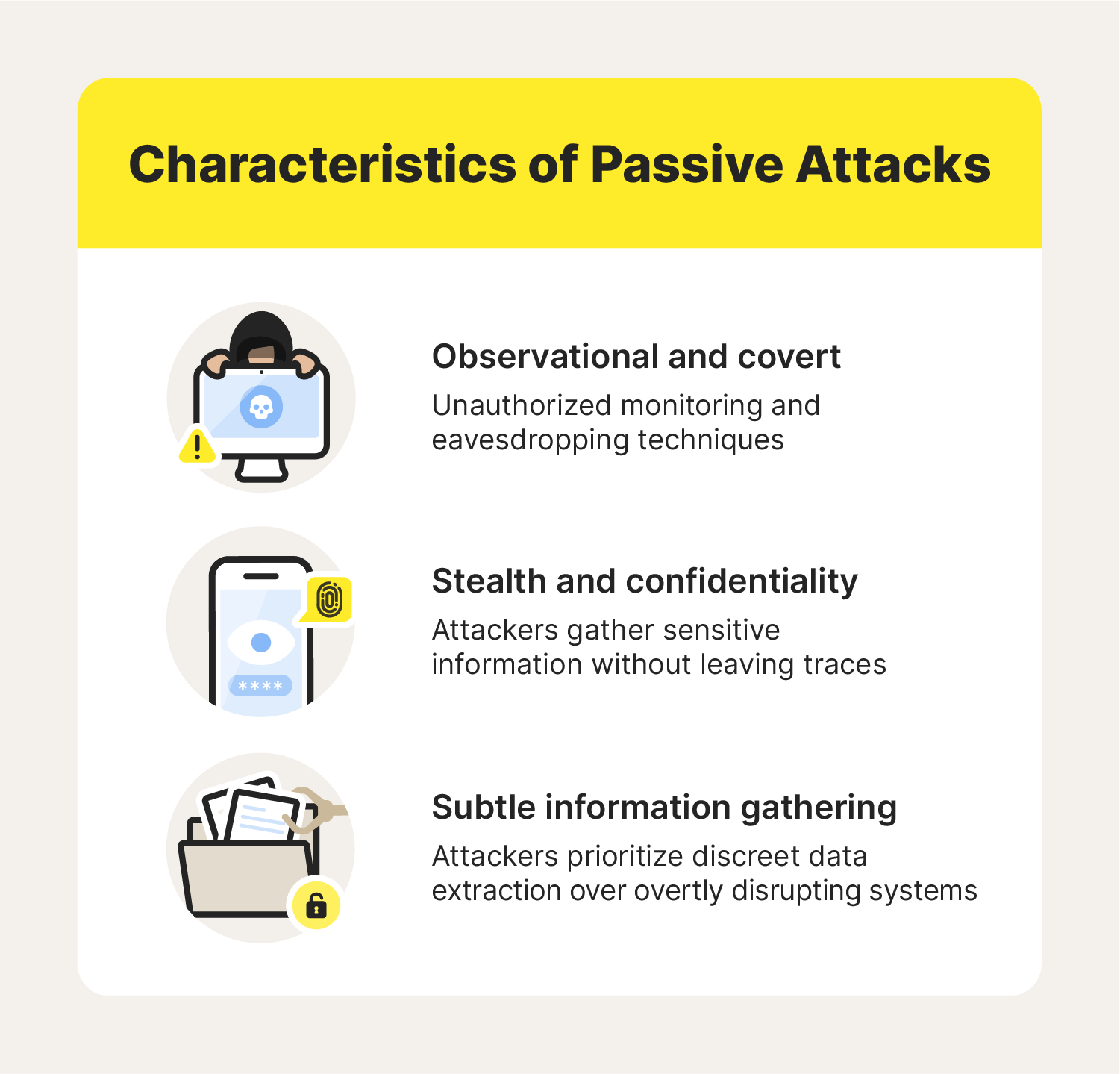What is an attack vector? 18 types + tips to avoid becoming a victim

An attack vector is the pathway cybercriminals utilize to exploit vulnerabilities in computer systems and networks. It is a way for hackers to unlock access to your data and systems. Dive into 18 types of attack vectors and learn tips to ensure a safer online experience, including using security tools like Norton 360 Deluxe to help protect your devices against hacking attacks.
What is an attack vector in cybersecurity?
In cybersecurity, an attack vector refers to the specific pathways or methods that cybercriminals employ to breach a computer system, network, or application's security. These vectors serve as the entry points into valuable data, making them a priority for cybersecurity professionals to address.
Attack vectors come in various forms, exploiting specific vulnerabilities or weaknesses in infrastructures. They encompass various techniques, from social engineering tactics like phishing emails to technical exploits such as software vulnerabilities or brute force attacks.
Attack vectors vs. vulnerabilities
Understanding the dynamics of cyber threats involves two concepts: attack vectors and vulnerabilities. Attack vectors refer to the methods and entry points cybercriminals use to launch their attacks. Vulnerabilities represent the weaknesses or flaws in a system, software, or network that attackers exploit, such as zero-day exploits. These vulnerabilities are like soft spots that attackers specifically target.
Attack vectors
These attack methods are not static; they continuously evolve. Cybercriminals frequently develop techniques and methods to bypass evolving security measures and technological advancements.
Attack vectors can take on many different forms, such as social engineering tactics like phishing emails, exploits that target software vulnerabilities, or even physical break-ins.

Vulnerability
Vulnerabilities refer to the flaws within a system, software, or network. Although they are not inherently harmful, they can be exploited to serve as entry points for attacks.
Vulnerabilities remain unchanged unless addressed. Cybersecurity professionals actively identify vulnerabilities through scanning and testing processes. These weaknesses may arise from coding errors, misconfigurations, or outdated software.
Proactive measures can often mitigate vulnerabilities or eliminate them entirely. This includes applying security patches, updating software regularly, and configuring systems correctly to reduce or eliminate risks.

Active vs. passive attacks
In cybersecurity, there is a distinction between active and passive attacks, each with its own unique characteristics and goals. Active attacks involve malicious actions aimed at disrupting, compromising, or gaining unauthorized access to a system, network, or data.
Active attacks
Active attacks refer to an individual’s attempts to access a system. In these attacks, the attacker actively aims to cause harm or extract information for malicious purposes.
They often require the attacker to interact with the system by sending harmful code such as Trojans and malware, exploiting vulnerabilities or attempting to bypass security measures.
Active attacks encompass a range of techniques and methods that vary based on the attacker’s objectives and targets. These methods may include injecting malware, launching brute force attacks, or executing man-in-the-middle attacks to intercept and manipulate data.

Passive attacks
Passive attacks are essentially non-disruptive. These attacks primarily involve monitoring or eavesdropping on communications or data exchanges without causing any alterations or disruptions.
The primary goal of passive attacks is to maintain an undetectable presence. Attackers aim to gather information such as data or confidential communications without leaving any traces or revealing their presence.
Passive attacks often revolve around techniques for collecting data, such as intercepting and analyzing network traffic to access sensitive information, wardriving, obtaining login credentials, and observing communication patterns.

Types of attack vectors
In cybersecurity, many attack vectors exist, representing diverse methods that malicious actors employ to compromise digital systems and data. Understanding these vectors can help maintain your online safety.
Each attack vector has distinct characteristics and potential risks, making it important to be aware of their existence and how to mitigate them effectively.
1. Phishing
Phishing is a scam tactic in which cybercriminals impersonate trusted entities, often through emails, messages, or deceptive websites, to obtain sensitive information.
How to avoid:
- Always scrutinize the sender's email address or domain to ensure it matches the expected source. Be cautious of slight deviations or misspellings in email addresses.
- Refrain from clicking on links within emails or messages from unverified or suspicious sources. Confirm URL destinations before clicking.
- Be skeptical of emails claiming you’ll suffer some type of loss if you don’t take immediate action. Cybercriminals often use this tactic to catch victims off guard.
2. Malware
Malware, short for "malicious software," is a broad category of software programs that infiltrate, damage, or compromise computer systems, networks, and devices.
Malware includes viruses, Trojans, worms, ransomware, and spyware and can lead to data theft, unauthorized network access, and more.
How to avoid:
- Always keep your software updated. Software updates can include security patches that help protect against known vulnerabilities that malware exploits.
- Only download software or files from reputable sources. Be cautious when downloading attachments from emails, especially if they are unexpected or from unknown senders.
- Install antivirus software across all your computer devices. Keep these programs updated to detect and remove malware threats in real-time and get additional protection against other online threats.
The consequences of malware can be severe with account takeovers and your personal information falling into the wrong hands. Take initiative and protect your devices and information with Norton 360 Deluxe and its multiplayer protection against malware.
3. Social engineering
Social engineering is a manipulative technique that exploits trust to deceive individuals in order to gain unauthorized access to systems or sensitive information.
Unlike traditional hacking methods that focus on exploiting technical vulnerabilities, social engineering targets human weaknesses, often relying on tactics like impersonation and manipulation.
How to avoid:
- Promote cybersecurity awareness within your organization. Training and educating users about common social engineering tactics and red flags can help them recognize and resist manipulation attempts.
- Verify the authenticity of the sender. Contact the sender through official channels or in person to confirm the request’s legitimacy before complying.
- Restrict access to sensitive systems and information based on the principle of "least privilege." Ensure that only authorized personnel have access to critical resources, reducing the potential for social engineering attacks to succeed.
4. Drive-by downloads
Drive-by downloads are a type of cyberattack where malicious software or code is automatically downloaded onto a user's device without their knowledge or consent when visiting a compromised or malicious website.
These downloads can install malware or unwanted software, potentially leading to system infections or data breaches. Drive-by downloads exploit vulnerabilities in web browsers or plugins to initiate the download.
How to avoid:
- Regularly update your web browser, plugins, and operating system to patch known security vulnerabilities. Cybercriminals often target outdated software to exploit security flaws.
- Enable browser security features, such as pop-up blockers and automatic security updates. These features can help prevent drive-by downloads by blocking pop-ups and ensuring your browser remains up-to-date.
- Employ reputable antivirus and anti-malware software that includes web protection features. These tools can detect and block malicious websites known for hosting drive-by download attacks, providing an additional layer of defense.
5. SQL injection
A SQL injection is a type of cyberattack that targets databases by injecting malicious SQL (Structured Query Language) code into input fields or user inputs on a website or application. This code manipulation can trick the database into revealing sensitive information, modifying data, or potentially taking control of the system. SQL injection exploits vulnerabilities in poorly sanitized user inputs, allowing attackers to manipulate database queries.
How to avoid:
- Developers should use prepared statements or parameterized queries and statements as they develop their code. These techniques separate user inputs from SQL queries, making it significantly harder for attackers to inject malicious code.
- Implement strict input validation on user inputs. Verify that the data submitted matches the expected format and is within acceptable ranges. Reject any input that appears suspicious or malicious.
- Conduct regular security audits and vulnerability assessments of your web applications and databases. Detect and promptly address any potential vulnerabilities to prevent SQL injection and other attacks.
6. Cross-site scripting (XSS)
Cross-Site Scripting (XSS) is when an attacker injects scripts (typically JavaScript) into web pages. These scripts run within the victim's browser, enabling the attacker to steal information, manipulate web content, or perform actions on behalf of the victim.
How to avoid:
- Ensure that user inputs are properly sanitized before displaying them on web pages. Filter and validate inputs to remove or neutralize any potentially harmful code or characters.
- Implement a Content Security Policy (CSP) to define which content sources are trusted and allowed to execute scripts. This can help prevent unauthorized scripts from running on your web pages.
- Leverage security libraries and frameworks that offer built-in protections against XSS attacks. Popular web development frameworks often include security features that can automatically escape or encode user-generated content to mitigate XSS risks.
7. Man-in-the-Middle (MitM)
In a man-in-the-middle attack, an unauthorized individual intercepts the communication between two parties who believe they are engaging in direct communication with one another.
In a MitM attack, the attacker secretly relays or modifies the messages exchanged between the victims, allowing them to eavesdrop on sensitive information. This attack can target various forms of communication, including emails, instant messaging, or secure web sessions.
How to avoid:
- Use encryption protocols such as HTTPS, SSL/TLS, and secure VPNs to encrypt the data exchanged between parties. Encryption will ensure communications cannot be deciphered.
- Implement strong authentication methods, including multifactor authentication (MFA), to verify the identity of the parties involved in the communication. This makes it more challenging for attackers to impersonate legitimate users.
- Continuously monitor network traffic for suspicious patterns or anomalies that may indicate a MitM attack.
8. Denial of Service (DoS) and Distributed DoS (DDoS)
Denial of Service (DoS) and Distributed Denial of Service (DDoS) attacks are efforts to disrupt the accessibility of a network, service, or website. In a DoS attack, either an individual attacker or a few compromised systems aim to crash a target website or server by overwhelming it with traffic, depleting its resources, and rendering it inaccessible to legitimate users.
DDoS attacks involve a network of compromised devices that are often spread worldwide. These devices work together to unleash a flood of traffic, making it more challenging to counteract and mitigate the impact.
How to Avoid:
- Implement traffic filtering and rate-limiting mechanisms that can differentiate between malicious traffic. Intrusion detection and prevention systems (IDS/IPS) and firewalls can be valuable in identifying and blocking patterns associated with DoS and DDoS attacks.
- Consider utilizing Content Delivery Networks (CDNs) to distribute web content across servers located in geographical areas. CDNs can mitigate the effects of DDoS attacks by distributing traffic evenly across servers while filtering out malicious requests.
- Ensure redundancy and load balancing within your infrastructure so that critical services remain available even if a server or network segment becomes targeted by an attack.
9. Brute force attack
A brute force attack is a method that cybercriminals use to gain access to systems, applications, and accounts. It involves trying all combinations of usernames and passwords until the correct credentials are found. This type of attack relies on the assumption that weak or easily guessable passwords are being used.
How to avoid:
- Use strong and unique passwords for each account or system. Secure passwords are long and complex, preferably using uppercase and lowercase letters, numbers, and special characters.
- Implement account lockout policies that temporarily suspend or lock user accounts after a number of failed login attempts. By doing this, attackers will be limited and hindered in their attempts
- Whenever possible, enforce MFA. MFA requires users to provide an additional authentication factor, such as a one-time code sent to their device, along with their password.
10. Credential stuffing
Credential stuffing involves cyber attackers using stolen usernames and passwords from one service or data breach to gain access to other online accounts belonging to the same individuals.
How to avoid:
- Avoid reusing passwords across accounts. Use a strong and unique password for each service or account. Password managers can assist in generating and securely storing passwords.
- Implement MFA whenever possible for your accounts. This adds a second layer of security by requiring users to provide an additional authentication factor to access their accounts.
- Regularly monitor your accounts for any signs of activity. If you receive login notifications or notice unfamiliar devices accessing your accounts, take action by changing your passwords and securing your accounts.
11. Physical attacks
Physical attacks in a cybersecurity context refer to physical attempts to gain access to computer systems, networks, or data physically. These attacks can manifest in ways such as stealing hardware, unlawfully entering data centers or server rooms, tampering with network cables or devices, and utilizing hardware devices to compromise security mechanisms.
How to avoid:
- Implement physical access controls that restrict entry into areas like data centers, server rooms, or network closets. Only authorized personnel should have access, and entry points should be secured with locks, biometric scanners, or access cards.
- Ensure the security of computers, servers, and networking equipment by using locks, cages, or enclosures. Never leave laptops and mobile devices unattended, and encrypt storage devices to safeguard data in case of theft.
- Deploy security cameras and monitoring systems in areas to record activities. Identify any unauthorized access. Regularly reviewing and analyzing surveillance footage will enable a prompt response to security incidents.
12. Malvertising
Malvertising refers to the distribution of malicious code through online advertisements. Attackers identify vulnerabilities in advertising networks and inject scripts into legitimate ads, resulting in the delivery of malware or redirection to malicious websites. Malvertising can infect user devices and compromise their security.
How to avoid:
- Consider using ad-blocking software or browser extensions as a measure against harmful ads. Ad blockers can filter out unwanted advertisements, reducing the risk of exposure to malvertising.
- Make sure that your web browser, browser plugins, and operating system are up to date and include the latest security patches. Many malvertising attacks specifically target known vulnerabilities that updates address.
- Exercise caution when interacting with ads found on unfamiliar or untrusted websites. Avoid clicking on ads that appear suspicious or make promises, and promptly close any pop-up ads.
13. Zero-day exploits
Zero-day exploits are security vulnerabilities or weaknesses found in software, applications, or operating systems that cybercriminals find and attack before developers know about them or can release patches or fixes. These vulnerabilities are called "zero-day" because developers didn’t know about the flaws before they were exploited, therefore they had zero days to fix them.
Zero-day exploits can be particularly dangerous as they leave users and organizations vulnerable to attacks to which there is no fix until software engineers identify the flaw and security updates become available.
How to avoid:
- Regularly update your software, operating systems, and applications. Developers often release patches that address known vulnerabilities, reducing the risk.
- Use intrusion detection and prevention systems to monitor and block malicious network traffic in real-time.
- Stay informed about emerging threats and vulnerabilities by following security blogs, forums, and threat intelligence feeds. Security researchers often share information about zero-day exploits, enabling organizations to defend against them or implement solutions until official patches become available.
14. Watering hole attacks
Watering hole attacks, a form of cyberattack, occur when attackers identify and infiltrate websites that their desired targets frequently visit. By exploiting known vulnerabilities in the website’s software or content management system, these attackers inject code or malware.
When targeted individuals visit these sites, they risk infecting their devices with malware. This can result in consequences such as data breaches, espionage, or further attacks. The term "watering hole" is derived from the behavior of predators waiting near watering holes for their prey to approach.
How to avoid:
- Ensure updates of your software, plugins, and content management systems. Keeping everything up to date reduces the risk of exploitation by watering hole attackers who often target known vulnerabilities.
- Limit access to your website and sensitive areas to only authorized personnel. Implement strong authentication mechanisms. Restrict privileges to minimize the possibility of attackers gaining control over your site.
- Continuously monitor your website's traffic and server logs for any unusual activities. Utilize intrusion detection systems and web application firewalls (WAFs) to effectively identify and block traffic associated with watering hole attacks.
15. Drive-by exploits
Drive-by exploits refer to cyberattacks that occur when a person visits a malicious website. These attacks exploit vulnerabilities in the user’s web browser, plugins, or operating system without requiring any action from the user.
Drive-by exploits can be used to install malware, steal data, or compromise a user’s device. Drive-by exploits take advantage of unpatched software.
How to avoid:
- Always keep your web browser, plugins, and operating system up to date by installing the security patches. Attackers often target known vulnerabilities that can be mitigated through updates.
- Activate security features in your web browser, like pop-up blockers and automatic security updates. These features help prevent drive-by exploits by blocking pop-ups and ensuring your browser is always up to date.
- Use antivirus and anti-malware software like Norton 360 Deluxe which includes web protection features that protect your privacy and identity, and block websites known for hosting drive-by exploit attacks, providing an additional layer of defense.
16. IoT vulnerabilities
IoT vulnerabilities are security weaknesses that exist in the interconnected devices and gadget ecosystem. These vulnerabilities can put devices at risk of unauthorized access, data breaches, and exploitation by hackers.
IoT devices encompass a range of technology, including home appliances, wearable devices, and industrial sensors. Due to their security features and the involvement of manufacturers and technologies, these devices are susceptible to attacks.
How to avoid:
- Always change the default usernames and passwords on your devices to unique credentials. Many attacks target devices with factory default login details, so it's important to set custom login information as soon as possible.
- Keep your IoT device firmware and software up to date. Manufacturers frequently release updates that address known vulnerabilities and enhance security. Enable updates when possible to ensure you receive the security fixes.
- Isolate your devices on a network from critical devices and sensitive data. This separation helps contain security breaches, limiting attacker access to resources if a device is compromised.
17. Eavesdropping
Eavesdropping refers to a technique used by individuals to secretly intercept and listen in on the communication between two parties. The main objective of eavesdropping is to gain access to sensitive information being transmitted, such as passwords, financial data, or proprietary business details.
These attacks usually focus on communication channels, making it relatively simple for attackers to intercept and gain access to the transmitted data.
How to Avoid:
- To prevent eavesdropping incidents, encrypt data and communications, including emails, using encryption protocols like SSL/TLS for web traffic or end-to-end encryption for messaging apps. Encryption ensures that any intercepted data is unreadable to eavesdroppers, maintaining its confidentiality.
- Use secure messaging apps or encrypted email services when sharing sensitive information. These platforms often incorporate encryption methods that protect your messages and data from eavesdroppers.
- Be careful when using Wi-Fi networks as they can be vulnerable to eavesdropping. It's best not to transmit any sensitive information over public Wi-Fi connections. When connecting to public Wi-Fi, use a VPN to encrypt your connection for added security.
With the Norton Secure VPN, you can secure your passwords and sensitive information while limiting your exposure while browsing at home or in public.
18. Insider threats
Insider threats in cybersecurity are the risks posed by individuals with privileged access to an organization’s systems, data, or facilities. These individuals can include employees, contractors, or business partners. They may exploit their access for purposes like data theft, sabotage, or espionage. Or, their unintentional actions can lead to security breaches.
Detecting and mitigating insider threats can be quite challenging as these individuals typically possess credentials and knowledge of the organization’s security measures.
How to avoid:
- Implement access controls. Follow the principle of "least privilege." This means granting individuals access to only the systems and data required for their specific roles. Regularly update access permissions to minimize risks.
- Conduct security awareness training programs for employees. Teach them how to recognize behavior so they can report concerns promptly.
- Continuously monitor user activities for any signs of suspicious behavior. Deploy user activity monitoring tools and auditing solutions that can help detect insider threats in time or through retrospective analysis.
Protect your devices from attack vectors
Attack vectors describe the many pathways cybercriminals utilize to infiltrate our networks and security systems. Knowing the different types of attack vectors can help you mitigate the risks posed by cyber threats and enhance your overall online safety.
Norton 360 Deluxe helps protect against malware, account takeovers, hacking, and other attack vectors. Plus, it features a built-in VPN to encrypt your connection and protect the data you share online.
Editorial note: Our articles provide educational information for you. Our offerings may not cover or protect against every type of crime, fraud, or threat we write about. Our goal is to increase awareness about Cyber Safety. Please review complete Terms during enrollment or setup. Remember that no one can prevent all identity theft or cybercrime, and that LifeLock does not monitor all transactions at all businesses. The Norton and LifeLock brands are part of Gen Digital Inc.





Want more?
Follow us for all the latest news, tips and updates.